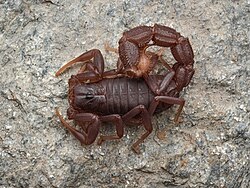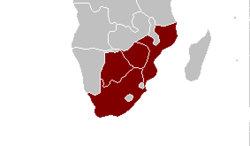Biology:Parabuthus transvaalicus
| Parabuthus transvaalicus | |
|---|---|

| |
| Parabuthus transvaalicus, sub-adult female | |
| Scientific classification | |
| Domain: | Eukaryota |
| Kingdom: | Animalia |
| Phylum: | Arthropoda |
| Subphylum: | Chelicerata |
| Class: | Arachnida |
| Order: | Scorpiones |
| Family: | Buthidae |
| Genus: | Parabuthus |
| Species: | P. transvaalicus
|
| Binomial name | |
| Parabuthus transvaalicus Purcell, 1899
| |

| |
Parabuthus transvaalicus (known as the Transvaalicus thick-tailed scorpion, South African thick tail, or giant deathstalker) is a species of venomous scorpion from semi-arid parts of southern Africa.[1]
Description
Parabuthus transvaalicus grows to a length of 90–110 millimetres (3.5–4.3 in), and is dark brown or black in colour, so it is also known as the Black Thick-Tailed scorpion.[2] Its pincers are thin, but its tail is thickened, with the sting segment being as wide as the rest of the tail.[2] It is nocturnal, resting in a shallow burrow under rocks during the day.[2] It resembles its congener P. villosus, which is less strictly nocturnal, hairier and has a more westerly distribution.[2]
Distribution
Parabuthus transvaalicus is found in deserts, scrublands and semi-arid regions of Botswana, Mozambique, Zimbabwe, some parts of the Namib Desert and South Africa .[3]
Sting
Parabuthus transvaalicus is a dangerous medically significant scorpion, which can both sting and spray its kurtoxin venom.[2] The first droplet of venom differs from the rest, and is referred to as "pre-venom".[4] A further potassium channel inhibitor, Parabutoxin, has been isolated from the venom of P. transvaalicus.[5]
References
- ↑ Norman Larsen. "Parabuthus transvaalicus (Transvaal thick-tailed scorpion)". Biodiversity Explorer. http://www.biodiversityexplorer.org/arachnids/scorpions/buthidae/parabuthus_transvaalicus.htm. Retrieved October 4, 2012.
- ↑ 2.0 2.1 2.2 2.3 2.4 Vincent Carruthers (2005). "Spiders and other arachnids". The Wildlife of Southern Africa: a Field Guide to the Animals and Plants of the Region. Struik. pp. 14–27. ISBN 978-1-86872-451-2. https://books.google.com/books?id=QygFIjP9jYUC&pg=PT40.
- ↑ Jan Ove Rein (2010). "Parabuthus transvaalicus (Purcell, 1899)". The Scorpion Files. Norges Teknisk-Naturvitenskapelige Universitet. http://www.ntnu.no/ub/scorpion-files/p_transvaalicus.php. Retrieved November 2, 2010.
- ↑ Bora Inceoglu; Jozsef Lango; Jie Jing; Lili Chen; Fuat Doymaz; Isaac N. Pessah; Bruce D. Hammock (2003). "One scorpion, two venoms: prevenom of Parabuthus transvaalicus acts as an alternative type of venom with distinct mechanism of action". Proceedings of the National Academy of Sciences 100 (3): 922–927. doi:10.1073/pnas.242735499. PMID 12552107. Bibcode: 2003PNAS..100..922I.
- ↑ Huys, I; Olamendi-Portugal, T; Garci-Goméz, BI; Vandenberghe, I (2004). "A subfamily of acidic alpha-K(+) toxins". J Biol Chem 279 (4): 2781–9. doi:10.1074/jbc.M311029200. PMID 14561751.
External links
Wikidata ☰ Q139192 entry
 |

